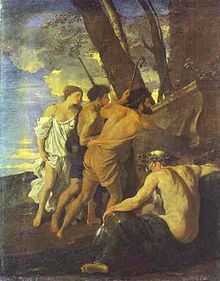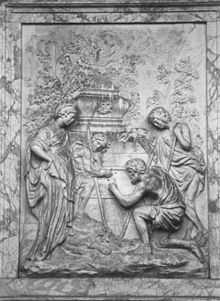Et in Arcadia ego
| Les Bergers d'Arcadie | |
|---|---|
 | |
| Artist | Nicolas Poussin |
| Year | 1637–1638 |
| Type | oil on canvas |
| Dimensions | 87 cm × 120 cm (34.25 in × 47.24 in) |
| Location | Musée du Louvre |
Et in Arcadia ego (also known as Les bergers d'Arcadie or The Arcadian Shepherds) is a 1637-38 painting by Nicolas Poussin (1594–1665). It depicts a pastoral scene with idealized shepherds from classical antiquity clustering around an austere tomb. It is held in the Louvre, Paris.
Poussin painted two versions of the subject under the same title; his earlier version, painted in 1627, is held at Chatsworth House. An earlier treatment of the theme was painted by Guercino circa 1618-22, also titled Et in Arcadia ego.
Title
The translation of the phrase is "Even in Arcadia, there am I". The usual interpretation is that "I" refers to death, and "Arcadia" means a utopian land. It would thus be a memento mori. During Antiquity, many Greeks lived in cities close to the sea, and led an urban life. Only Arcadians, in the middle of the Peloponnese, lacked cities, were far from the sea, and led a shepherd life. Thus for urban Greeks, especially during the Hellenistic era, Arcadia symbolized pure, rural, idyllic life, far from the city.
However, Poussin's biographer, André Félibien, interpreted the phrase to mean that "the person buried in this tomb lived in Arcadia"; in other words, that the person too once enjoyed the pleasures of life on earth. This reading was common in the 18th and 19th centuries. For example William Hazlitt wrote that Poussin "describes some shepherds wandering out in a morning of the spring, and coming to a tomb with this inscription, 'I also was an Arcadian'."[1]
The former interpretation ("ego" referring to death) is now generally considered more likely; the ambiguity of the phrase is the subject of a famous essay by the art historian Erwin Panofsky (see References). Either way, the sentiment was meant to set up an ironic contrast between the shadow of death and the usual idle merriment that the nymphs and swains of ancient Arcadia were thought to embody.
Inspiration

The first appearance of a tomb with a memorial inscription (to Daphnis) amid the idyllic settings of Arcadia appears in Virgil's Eclogues V 42 ff. Virgil took the idealized Sicilian rustics that had first appeared in the Idylls of Theocritus and set them in the primitive Greek district of Arcadia (see Eclogues VII and X). The idea was taken up anew in the circle of Lorenzo de' Medici in the 1460s and 1470s, during the Florentine Renaissance.
In his pastoral work Arcadia (1504), Jacopo Sannazaro fixed the Early Modern perception of Arcadia as a lost world of idyllic bliss, remembered in regretful dirges. The first pictorial representation of the familiar memento mori theme that was popularized in 16th-century Venice, now made more concrete and vivid by the inscription ET IN ARCADIA EGO, is Guercino's version, painted between 1618 and 1622 (in the Galleria Nazionale d'Arte Antica, Rome), in which the inscription gains force from the prominent presence of a skull in the foreground, beneath which the words are carved.
1627 version

Poussin's own first version of the painting (now in Chatsworth House) was probably commissioned as a reworking of Guercino's version. It is in a far more Baroque style than the later version, characteristic of Poussin's early work. In the Chatsworth painting the shepherds are actively discovering the half-hidden and overgrown tomb, and are reading the inscription with curious expressions. The shepherdess, standing at the left, is posed in sexually suggestive fashion, very different from her austere counterpart in the later version. The later version has a far more geometric composition and the figures are much more contemplative. The mask-like face of the shepherdess conforms to the conventions of the Classical "Greek profile".
Interpretation
The most important difference between the two versions is that in the latter version, one of the two shepherds recognizes the shadow of his companion on the tomb and circumscribes the silhouette with his finger. According to an ancient tradition (see Pliny the Elder, nat. Hist. XXXV 5, 15), this is the moment in which the art of painting is first discovered. Thus, the shepherd's shadow is the first image in art history. But the shadow on the tomb is also a symbol of death (in the first version symbolized by a skull on the top of the tomb). The meaning of this highly intricate composition seems to be that, from prehistory onward, the discovery of art has been the creative response of humankind to the shocking discovery of mortality. Thus, death’s claim to rule even Arcadia is challenged by art (symbolized by the beautifully dressed maiden), who must insist that she was discovered in Arcadia too, and that she is the legitimate ruler everywhere, whilst death only usurps its power. In the face of death, art's duty—indeed, her raison d’être—is to recall absent loved ones, console anxieties, evoke and reconcile conflicting emotions, surmount isolation, and facilitate the expression of the unutterable.[2]
Sculpted versions

The undated mid-eighteenth-century marble bas-relief is part of the Shepherds Monument, a garden feature at Shugborough House, Staffordshire, England. Beneath it is the cryptic Shugborough inscription, as yet undeciphered.[3] The reversed composition suggests that it was copied from an engraving, the compositions of which are commonly reversed because direct copies to the plate produce mirror images on printing.
In 1832 another relief was sculpted as part of the monument marking Poussin's tomb in Rome, on which it appears beneath a bust of the artist.[4] In the words of the art historian Richard Verdi, it appears as if the shepherds are contemplating "their own author's death."[5]
References in other works
|
|
- Et in Arcadia ego (the German Auch ich in Arkadien! is used) is the motto of Italian Journey (1816−17) by Johann Wolfgang von Goethe.[6]
- Et in Arcadia ego is the title of section 295, Volume II, Part Two ("The Wanderer and his Shadow"), of Friedrich Nietzsche's Human, All Too Human (1880). The passage describes a pastoral evening scene in the high mountains, finishing with the lines: "Unconsciously, as if nothing could be more natural, you peopled this pure, clear world of light (which had no trace of yearning, of expectancy, of looking forward or backward) with Greek heroes. You felt it all as Poussin and his school felt it, at once heroic and idyllic. So individual men too have lived, constantly feeling themselves in the world and the world in themselves, and among them one of the greatest men, the inventor of a heroico-idyllic form of philosophy, Epicurus."[7]
- Et in Arcadia Ego is the title of Book One of Evelyn Waugh's Brideshead Revisited in which a skull bearing the phrase acts as a metaphor for death and for a yearning for a lost paradise resulting from the transformation of war.[8]
- Et in Arcadia Ego is the title of a dystopian poem published by W. H. Auden in 1965. [9]
- In conjunction with John Andrew, the artist Ian Hamilton Finlay created a marble carving entitled Et in Arcadia ego in 1976. The main part of the carving shows a military tank in a pastoral landscape, below which are carved the title and the words "After Nicholas Poussin". Several other works by Finlay directly or indirectly reference Poussin's artwork.[10]
- The phrase appears in Cormac McCarthy's novel Blood Meridian when the character Tobin informs The Kid that the phrase is the name Judge Holden has ascribed to his rifle, noting "A reference to the lethal in it."[11]
- Ben Okri's In Arcadia follows a filmcrew shooting a documentary about Nicolas Poussin's painting.[12]
- The authors of the pseudohistory The Holy Blood and the Holy Grail, under the false impression that "et in arcadia ego" was not a proper Latin sentence, proposed that it is an anagram for I! Tego arcana dei, which translates to "Begone! I keep God's secrets", suggesting that the tomb contains the remains of Jesus or another important Biblical figure.
- Et in Arcadia ego was the originally planned title of Tom Stoppard's play, Arcadia, in which the phrase is used erroneously by one character (whose misuse is acknowledged by two other characters). The phrase also reflects the themes of the play itself.[13]
- "Et in Arcadia Ego" is also the title of a work by the Czech science fiction writer Simon Sedivak, where Arcadia is described as a planet.
- In Earthquake Weather by Tim Powers, the phrase, interpreted as an unfinished sentence meaning "Even in Arcadia, I...", plays a recurring role, tied into the book's themes of the Fisher King and Dionysus in his role as a psychopomp.
- Arcadia was the name of Duran Duran's spin off band formed in 1985 by Simon Le Bon, Nick Rhodes and Roger Taylor, reportedly because of the inscription on this painting.[14]
See also
Notes
- ↑ "Why the arts are not progressive -- A fragment". The round table: a collection of essays on literature, men, and manners, by William Hazlitt. Edinburgh and London: Constable. 1817. p. 258.
- ↑ Cf. Becht-Jördens, Gereon; Wehmeier, Peter M. (2003). Picasso und die christliche Ikonographie. Dietrich Reimer Verlag, Berlin. pp. 181–209
- ↑ "The Shepherd's Monument". Shugborough. Retrieved 2011-07-26.
- ↑ http://www.duepassinelmistero.com/_borders/POUSSIN_3.jpg
- ↑ Warwick, G. & Scott, K., Commemorating Poussin: Reception and Interpretation of the Artist, Cambridge University Press, 1999. Cf. "Introduction: Commemorating Poussin" by Katie Scott, p. 9. "As Richard Verdi has noted, this change of context resulted in Poussin's shepherds being led to contemplate their own author's death, and invited the viewer to ponder the monument with the same solemnity and poignancy with which the shepherds brood on Death's incursion into Arcadia."
- Also cf. Verdi, Richard, "Poussin's giants: from romanticism to surrealism", in this collection.
- ↑ Johann Wolfgang von Goethe, Italienische Reise, www.gutenberg.org. Retrieved 24 October 2012.
- ↑ Friedrich Nietzsche, Human, All Too Human, archive.org. Retrieved 24 October 2012.
- ↑ Stevenson, Randall (1993). A Reader's Guide to the Twentieth-century Novel in Britain. University Press of Kentucky. pp. 87–. ISBN 0-8131-0823-3. Retrieved 2 September 2014.
- ↑ Auden, W.H. (1965-06-03). "Et in Arcadia Ego". The New York Review of Books.
- ↑ Abrioux, Yves (1985), Ian Hamilton Finlay: A Visual Primer, Reaktion Books, pp. 205–207, ISBN 0-948462-00-0
- ↑ McCarthy, Cormac. Blood Meridian, or, The Evening Redness In The West (New York: Random House, 1985; London: Picador, 1989).
- ↑ Okri, Ben. In Arcadia (Weidenfeld & Nicolson, London, 2002). ISBN 978-0-297-82960-7.
- ↑ Fleming, Tom. Stoppard's "Arcadia" (Modern Theatre Guides, London: Continuum). ISBN 978-0-8264-9621-8.
- ↑ "Music - Arcadia". BBC. 2009-03-15. Retrieved 2011-07-26.
References
- Brandt, Reinhard (2000). Philosophie in Bildern. DuMont Buchverlag, Köln. pp. 265–282. ISBN 3-7701-5293-X.
- Panofsky, Erwin (1983). Meaning in the Visual Arts. University of Chicago Press. ISBN 0-226-64551-7.
Further reading
- Verdi, Richard, "On the Critical Fortunes - And Misfortunes - Of Poussin's 'Arcadia'", The Burlington Magazine, Vol. 121, No. 911 (Feb., 1979), pp. 95–107
- Becht-Jördens, Gereon; Wehmeier, Peter M. (2003). Picasso und die christliche Ikonographie. Dietrich Reimer Verlag, Berlin. pp. 181–209. ISBN 3-496-01272-2.
- Panofsky, Erwin and Gerda, "The „Tomb in Arcady“ at the „Fin-de-Siècle“", Wallraf-Richartz-Jahrbuch, 30 (1968), pp. 287–304.
- Patton, Guy "Poussin's Arcadian Vision: Search for the Golden Age", Amazon books, 2014
External links
| Wikimedia Commons has media related to Et in Arcadia ego. |
- Marc Wiesmann, "Classical Arcadia"
- Guercino's painting illustrated at the official Galleria Barberini website (text in Italian)